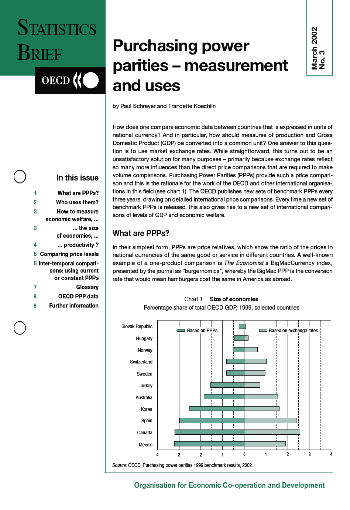Purchasing Power Parities, an introduction
Purchasing Power Parities (PPPs) are a mechanism increasingly used by many multilateral organizations, governments, the academia and civil society organizations to compare key economic indicators between countries. In the simplest way, PPPs act as a deflator to harmonize the value of goods and services between economies, by expressing a virtual universal currency or a common unit of value. Exchange rates are determined not only by the supply and demand of a currency but also by the monetary policy of each country and, thus, do not reflect the true equivalence in the value of goods between countries. PPPs instead eliminate such effects and represent a true relationship between the price differences of a basket of goods and services between two economies or markets or between any combinations of them. Main use of PPPs
PPPs are typically used to represent GNI (formerly GNP) in PPP terms (or for GDP as well). To do this a benchmark must be established, which is usually a country or a group of countries, i.e., the GNI PPP for a specific country in relation to the U.S. or to the average for the European Union. An example very illustrative of its use is precisely the European Union. Now that most members of the EU share the Euro as its common currency, there is still the need to use the PPPs as currency converter for both Euro and non-Euro members. This is because although Euro members can now compare prices in the same currency, they still need to eliminate individual economy inflationary effects. Thus, whilst PPPs act as a common currency for price comparisons in non-Euro members, they also act as a price deflator in both Euro members and non-members. In this way, PPPs, by establishing a virtual currency or Purchasing Power Standard (PPS), harmonize the aggregates of volumes between countries for the purpose of comparisons (as in apples with apples). Limitations of PPPs
To be sure, PPPs do not embody a perfect mechanism to eliminate a variety of factors that have a direct effect on prices, given specific aspects of the estimation and data collection procedures. For instance, it is difficult to find exactly all the same products of a goods and services basket between two countries, or the aggregate method to group goods and services into specific categories may differ. Thus, while PPPs comparisons are an effective tool to establish relationships of economic indicators and price levels between countries, they are not an exact measurement. PPP use in TLWNSI
For the work of The Jus Semper Global Alliance, PPPs are an extremely useful tool to assess the differences in the price levels of equivalent labour functions in different countries. To fulfil our mission, as it is advanced in TLWNSI, to gradually harmonize wages between equivalent workers of the same corporation doing the same or a very similar job, there is no more effective measure of comparison than the PPPs mechanism. PPPs, in this case, reflect the differences in purchasing power between two economies relative to a common basket of goods. It can be expressed in both the currency unit of the country in question or in the currency unit of the country used as the benchmark. It reflects the ratio between the number of currency units that are necessary to have the same purchasing power as the benchmark has with one of its currency units. Then, this relationship can be extrapolated to the specific wages of workers of the same corporations performing the same tasks. In this way, we can determine how far or how close the purchasing power provided by the wages of a worker in a country in question is from the purchasing power of the worker in the benchmark country. The purpose is to determine the same purchasing power for both workers of the same company working in different countries but performing the same job for a product that is being marketed in global markets at global prices. In this way, we can set a specific wage-price level in order to advance our goal of gradually closing the gap in real wages for equivalent workers of the same multinational, parting from the premise that both workers have the right to enjoy the same quality of life in material terms. An Illustrative Case
A clear example is the wage comparison of production workers in manufacturing in NAFTA countries, using the U.S. wages and the U.S. dollar as benchmarks, . To construct the table, we used hourly wages reported by the U.S. Department of Labour for Canada, Mexico and the U.S. PPPs were determined by establishing the index ratio between the GNI and the PPP GNI reported by The World Bank for the year 2004 in U.S. Dollars. Applying this index to the nominal exchange rate of each country determines the real exchange rate. However, in this table we directly apply the index to the nominal wage of U.S. workers to determine the equivalent nominal wage of Canadian and Mexican workers necessary to provide an equivalent purchasing power. In this way, the indexes of 92 and 70 of Canada and Mexico, respectively, indicate lower costs of living, for they need $0.92 and $0.70 U.S. Cy. to buy the same goods and services that one dollar can buy in the U.S. For this reason, the real wages for both countries are higher than their nominal wages, because each dollar has a stronger purchasing power in each country as shown in the following column. Thus, the nominal wage required to equalize the same real wage of equivalent U.S. workers is lower than the U.S. wage, due to the lower cost of living at a ratio of 70 and 92 for each dollar of the U.S. hourly wage rate. The last column is an index indicating how close or how far Canadian and Mexican workers are from earning an equivalent wage to that of their U.S. Counterparts.
TOP
For further details on the use of PPPs, we suggest the following briefs:
- Purchasing Power Parities and related economic indicators for EU, Acceding and Candidate Countries and EFTA1. Final results for 2000 and preliminary results for 2001 Manuscript completed on: 15.12.2002 ISSN 1024-4298 Catalogue number: KS-NJ-02-056-EN-N © European Communities, 2002 Available to Download pdf directly from our website.
- Purchasing power parities - measurement and uses by Paul Schreyer and Francette Koechlin. The Statistics Brief, March 2003. The Statistics Brief is published by the Statistics Directorate of the OECD © OECD. Available to Download pdf directly from our website or go to the OECD PPPs page clicking here.
- Comparative Real Gross Domestic Product Per Capita and Per Employed Person, Fourteen Countries, 1960-2003. Prepared by: U.S. Department of Labor Bureau of Labor Statistics Office of Productivity and Technology http://www.bls.gov/fls/ July 26, 2004. Available to Download pdf directly from our website.
|







